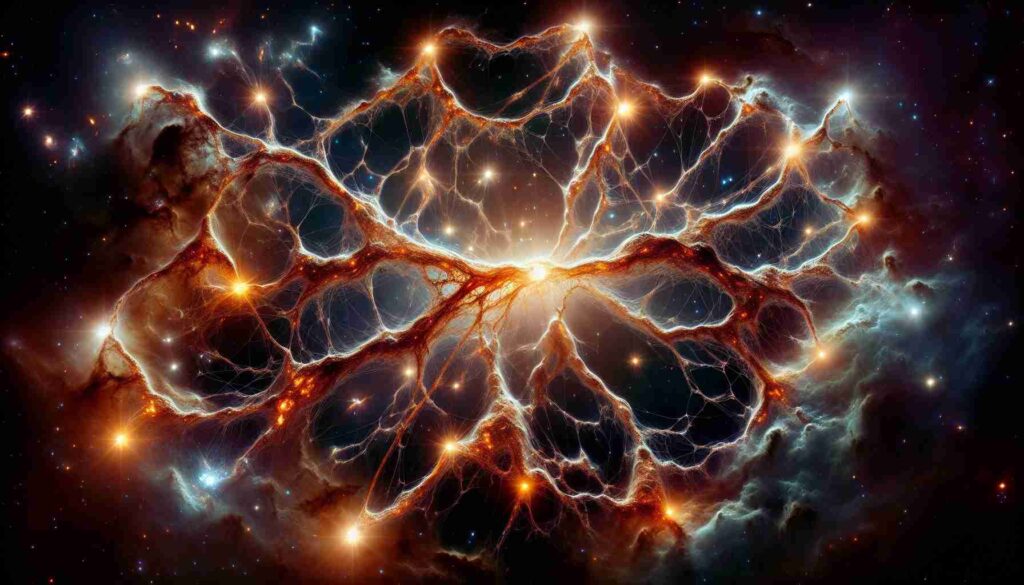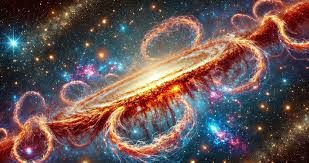
Introduction
In a groundbreaking discovery that has left the scientific community in awe, astronomers have identified the largest known structure in the universe—a colossal cosmic formation named Quipu. Spanning an astonishing 1.3 billion light-years, this superstructure is more than 13,000 times the length of the Milky Way and could fundamentally reshape our understanding of the universe’s large-scale architecture.
Named after the ancient Incan measuring system, Quipu is not just a marvel of size but also a key to unlocking the mysteries of cosmic motion, galaxy evolution, and the distribution of matter in the universe. Let’s dive deeper into this monumental discovery and explore its implications for cosmology.
Quipu: A Superstructure Unlike Any Other
Quipu stands out as a unique and unprecedented discovery in the field of astronomy. To put its size into perspective, the Milky Way galaxy, which is home to our solar system, spans approximately 100,000 light-years. on the other hand, stretches 1.3 billion light-years, making it one of the most massive structures ever observed.
This discovery was made while analyzing data on galaxy clusters, which are dense regions of the universe containing hundreds or even thousands of galaxies. The study, which is available on ArXiv and awaits peer review, highlights Quipu’s significance in the local universe.
Previously, the Hercules-Corona Borealis Great Wall held the title for the largest known structure, spanning an estimated 10 billion light-years. However, its existence remains disputed among scientists. In contrast, Quipu is clearly visible in sky maps, making it a more concrete and observable phenomenon.
The Discovery of Quipu and Other Superclusters

While Quipu is the star of this discovery, astronomers also identified four other massive superclusters in the same region of the universe. These superstructures, together with Quipu, account for a significant portion of the universe’s observable matter. Specifically, they contain:
- 45% of galaxy clusters
- 30% of galaxies
- 25% of observable matter
This image displays the five newly identified superstructures:
- Quipu (red) – The largest in the local universe.
- Shapley (blue) – A well-known supercluster.
- Serpens-Corona Borealis (green) – A massive formation in the northern sky.
- Hercules (purple) – Part of the disputed Hercules-Corona Borealis Great Wall.
- Sculptor-Pegasus (beige) – A lesser-known but significant supercluster.
These superclusters are not just random collections of galaxies; they are interconnected by vast filaments of dark matter and gas, forming a cosmic web that defines the universe’s large-scale structure.
Quipu’s Role in Cosmic Motion
Superclusters like Quipu are more than just static collections of galaxies—they play a dynamic role in the universe. The Milky Way, for instance, is part of the Laniakea Supercluster, which spans over 500 million light-years. Similarly, it exerts a significant gravitational influence on its surroundings.
Researchers suggest that Quipu contributes to the gravitational pull affecting the Local Group, a collection of galaxies that includes the Milky Way and Andromeda. This gravitational influence impacts the movement of the Local Group relative to the Cosmic Microwave Background (CMB), the afterglow of the Big Bang.
However, the exact extent of it’s influence on cosmic motion is still under investigation. Further studies are needed to confirm how this superstructure shapes the movement of galaxies and other cosmic entities in its vicinity.
A Temporary Cosmic Formation
Despite its immense size and significance, Quipu is not a permanent fixture in the universe. Scientists describe it as a “transient configuration”—a temporary arrangement that will eventually break apart into smaller, collapsing units. Over billions of years, the gravitational forces within Quipu will cause it to fragment, leading to the formation of smaller superclusters and galaxy clusters.
This transient nature is a reminder of the ever-changing cosmos. While Quipu may dominate the local universe today, its eventual dissolution will contribute to the ongoing evolution of the universe’s large-scale structure.
Implications for Cosmology
The discovery of Quipu has far-reaching implications for our understanding of the universe. Here are some key areas where this discovery could make an impact:
- Refining Cosmological Models:
It’s size and structure provide valuable data for refining existing cosmological models. By studying its properties, scientists can gain insights into the distribution of matter and the forces shaping the universe. - Understanding Galaxy Evolution:
Superclusters like Quipu serve as natural laboratories for studying galaxy formation and evolution. The dense environments within these structures can accelerate the growth of galaxies and influence their development. - Probing Dark Matter and Dark Energy:
The gravitational effects of this and other superclusters can help scientists probe the nature of dark matter and dark energy, two of the most mysterious components of the universe. - Mapping the Cosmic Web:
Quipu’s discovery adds another piece to the puzzle of the cosmic web—the intricate network of filaments and voids that define the universe’s large-scale structure.
The Need for Further Research
While the discovery of Quipu is a monumental achievement, it also raises many questions. How did such a massive structure form? What role does it play in the universe’s evolution? And how will its eventual fragmentation affect the surrounding regions?
To answer these questions, astronomers will need to conduct further observations and simulations. Advanced telescopes, such as the James Webb Space Telescope (JWST) and the upcoming Vera C. Rubin Observatory, will play a crucial role in studying Quipu and other superstructures in greater detail.
Conclusion
The discovery of Quipu, the largest known object in the universe, marks a significant milestone in astronomy. This colossal superstructure, spanning 1.3 billion light-years, challenges our understanding of the universe’s large-scale architecture and opens new avenues for research.
As scientists continue to study and its impact on cosmic motion, galaxy evolution, and the distribution of matter, we can expect to gain deeper insights into the mysteries of the cosmos. Quipu is not just a testament to the universe’s grandeur but also a reminder of how much we have yet to learn about the vast expanse of space.
Key Takeaways:
- Quipu is the largest known structure in the universe, spanning 1.3 billion light-years.
- It is 13,000 times the size of the Milky Way and clearly visible in sky maps.
- It influences cosmic motion and plays a role in the gravitational pull affecting the Local Group.
- The discovery of Quipu and other superclusters could refine cosmological models and enhance our understanding of galaxy evolution.
- Further research is needed to fully understand Quipu’s formation, impact, and eventual fragmentation.